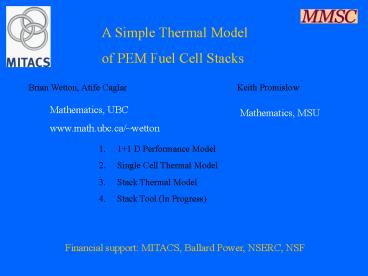A Simple Thermal Model - PowerPoint PPT Presentation
1 / 9
Title:
A Simple Thermal Model
Description:
Through MEA (z) transport decouples from channel flow (y) ... Approximations to these quantities are obtained from a 1 1 D performance model. Berg et al 2003 ... – PowerPoint PPT presentation
Number of Views:20
Avg rating:3.0/5.0
Title: A Simple Thermal Model
1
A Simple Thermal Model of PEM Fuel Cell Stacks
Brian Wetton, Atife Caglar
Keith Promislow
Mathematics, UBC www.math.ubc.ca/wetton
Mathematics, MSU
- 11 D Performance Model
- Single Cell Thermal Model
- Stack Thermal Model
- Stack Tool (In Progress)
Financial support MITACS, Ballard Power, NSERC,
NSF
2
11 D Models
- Straight Channels (Ballard Mk9)
- Averaged over width (x)
- Through MEA (z) transport decouples from channel
flow (y) - Steady State
Not new Fuller and Newman 1991, Yi and Nyguyen
1998, Freunberger et al. 2003.
3
Sources of Heat
Performance Model Output
- Condensation
- Overpotential
- Membrane Resistivity
- Cell Voltage
- Overpotential
- Water flux
- Membrane Resistivity
- Current density
Approximations to these quantities are obtained
from a 11 D performance model Berg et al 2003
Voltage losses
4
Unit Cell Coolant Temperature T(y)
Assume heat is only removed through the coolant
stream
One step of an iterative procedure to determine
consistent T(y)
5
Unit Cell Through MEA profile
- Further Assumptions
- Condensation is uniform in the cathode electrode
- Ohmic heating is uniform in the membrane
- Thermal Transfer to the coolant can be described
by Nusselt number
We obtain a linear system for each y for
Describes one cell in a uniform stack
is piecewise linear/quadratic
6
Unit Cell Through MEA profile
7
Stack Model
Anomalous cell has quadrupled resistivity
(systematic vs anomalous sensitivities)
8
Stack Model (cont)
Local (y) unknowns
Implicit solve 6N by 6N unknowns at each channel
grid point.
9
Stack Tool (In progress)
These thermal models are part of a larger
programme to build a computational Stack
Modelling Tool.
- Header flow sharing can be neglected.
- Remaining stack effects are electrical and
thermal - A preliminary stack tool has been developed with
these effects.
- Unit Cell Improvements (In Progress)
- 1D MEA transport including liquid water
- Parametric effects of liquid water in channels
- 2D MEA transport models































